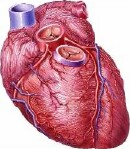
TUESDAY, March 5 (HealthDay News) — Scarring in the heart’s wall may be a key risk factor for death, and scans that calculate the amount of scarring might help in deciding which patients need particular treatments, a new study suggests.
At issue is a kind of scarring, or fibrosis, known as midwall fibrosis. Reporting in the March 6 issue of the Journal of the American Medical Association, researchers found that patients with enlarged hearts who had more of this type of damage were more than five times more likely to experience sudden cardiac death compared to patients without such scarring.
“Both the presence of fibrosis and the extent were independently and incrementally associated with all-cause mortality [death],” concluded a team led by Dr. Ankur Gulati of Royal Brompton Hospital, in London.
In the study, the researchers took high-tech MRI scans of the hearts of 472 patients with dilated cardiomyopathy, a form of weakened and enlarged heart that is often linked to heart failure. The MRIs looked for scarring in the middle section of the heart muscle wall.
Tracking the patients for an average of more than five years, the team reported that while about 11 percent of patients without midwall fibrosis had died, nearly 27 percent of those with such scarring had died.
According to Gulati’s team, assessments of midwall scarring based on MRI imaging might be useful to doctors in pinpointing which patients with enlarged hearts are at highest risk for death, irregular heart rhythms and heart failure.
Experts in the United States agreed that gauging the extent of scarring on the heart provides useful information.
“The severity of the dysfunction can be linked to the extent with which healthy heart muscle is replaced by nonfunctioning scar tissue,” explained Dr. Moshe Gunsburg, director of the cardiac arrhythmia service and co-chief of the division of cardiology at Brookdale University Hospital and Medical Center, in New York City.
“Cardiologists utilize a vast array of very sophisticated noninvasive and invasive testing [methods] to not only assess a patient’s risk of experiencing sudden arrhythmic cardiac death, but to also distinguish areas of potentially viable heart muscle from scar tissue,” Gunsburg added.
Looking for heart wall scarring with newer, more advanced MRI scanning is one more tool that might be used, he said. Patients should discuss this and other approaches with their doctor, to maximize their cardiovascular care.
Another expert agreed.
“The ability to see fibrosis can actually [help] risk-stratify patients with cardiomyopathy,” said Dr. Suzanne Steinbaum, a preventive cardiologist at Lenox Hill Hospital, in New York City. She believes the technique may “allow us to more aggressively prevent sudden cardiac death.”
In a separate study, published in the same issue of JAMA, researchers led by Dr. Dipan Shah, of Duke University Medical Center, said they’ve made an encouraging discovery about the recovery of damaged heart tissue.
In the past, it’s been assumed that a thinning of the heart muscle was an unhealthy, irreversible part of coronary artery disease for many patients. But in their study of 201 heart patients with such thinning, the Duke team found that about 18 percent had either limited or no tissue scarring, and this lack of scarring was associated with better heart muscle function.
This may mean that heart wall “thinning is potentially reversible and therefore should not be considered a permanent state,” Shah’s team wrote.
For her part, Steinbaum said the finding was encouraging.
“Cardiovascular [MRI] has now shown that this thinning might not be a sign of a scar, and may actually represent heart muscle that could recover function if treated,” she said. “With this greater ability to visualize the heart muscle after a heart attack, we can now treat patients more thoroughly to potentially allow their heart muscle to regain function and have better outcomes.”
More information
Find out more about dilated cardiomyopathy at the U.S. National Library of Medicine.

